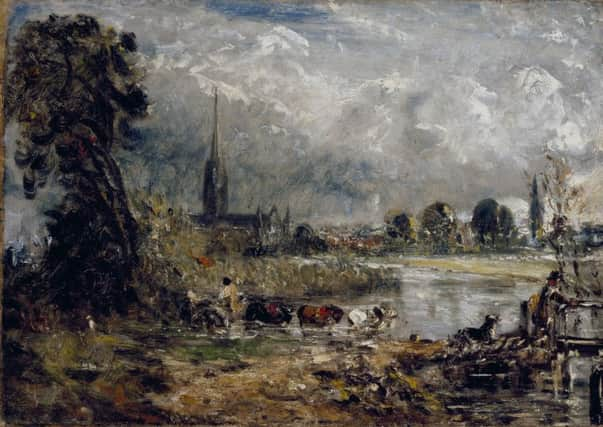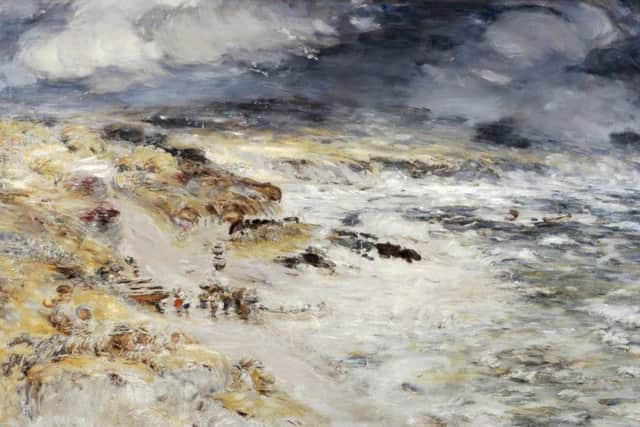Art review: Constable & McTaggart: A Meeting of Two Masterpieces | The Tomb: Ancient Egyptian Burial


Constable & McTaggart: A Meeting of Two Masterpieces Scottish National Gallery, Edinburgh ****
The Tomb: Ancient Egyptian Burial National Museum of Scotland, Edinburgh ****
Advertisement
Hide AdAdvertisement
Hide AdThe National Gallery has a Very Important Visitor. Constable’s painting, Salisbury Cathedral from the Meadows, one of the most ambitious of all his big exhibition pictures, was recently acquired for the Tate and is now being exhibited around the country.


The presence in Edinburgh of such a grand picture is very welcome, but it is also appropriate. Constable is now regarded as the quintessential English painter, the man who defined English landscape, but it was not always so. Indeed in his lifetime, what recognition he did achieve was grudging. He was eventually elected to the Academy, but late in his life – a sight he felt acutely. After his death, his reputation, such as it had been, went into eclipse. In consequence, it is hard to find the influence of this most English of artists anywhere in English art.
It was not so in France, however. French naturalistic landscape, now so celebrated in the work of the Impressionists, took much inspiration from Constable. The same was also true in Scotland. Indeed, his greatest British follower was William McTaggart. Appropriately therefore, the National Gallery has taken the opportunity to show McTaggart’s The Storm alongside this major loan, together with some sketches by Constable, other work by McTaggart and a small number of drawings by both men. Separately, there is also a display of mezzotints after Constable by his close collaborator David Lucas.
But the main thing is the pairing of Constable’s Salisbury Cathedral and McTaggart’s Storm. Hanging together, they do look terrific. Through his observation of transient weather effects, of clouds, which he particularly studied, and the flickering of sunlight on vegetation which is rarely still, and on water, Constable introduced a sense of time and of our subjective experience of nature into landscape painting. It was perhaps too radical for his contemporaries. McTaggart was not put off and if Constable’s work was not easily seen in the 19th century, he was also lucky. For a period in the 1880s, a large group of Constable’s sketches was loaned to the Royal Scottish Museum (now the National Museum of Scotland), where he was able to study them.
When you see the two men’s work side by side you see what McTaggart learnt, but also how he went further than Constable. In The Storm he gives us a sense of the confusion of the battering wind and the wild sea. Everything is in flux. Henry Fuseli, who had a heavy German accent, once remarked looking at a painting by Constable: “Ven I see his paintings, I vish I had brought my umbrella.” With McTaggart’s picture his umbrella would instantly be blown inside out. But in this McTaggart is also unmistakably modern. Here, but also in the tranquil summer scene of Harvest at Broomieknowe hanging nearby, he focuses on the immediate and subjective, the physical rather than the mental. His paintings are existential, existentialist even. The drama of the boats trying to reach port through the raging storm is lost in the overwhelming physical drama of wind, rain and spray. It is only a step from the all-consuming surface of his picture to Jackson Pollock.


In his painting, however, Constable clearly wants to find balance. The drama of storm clouds and the rainbow arching above the soaring cathedral spire is grand, but it is also stable, ordered: life has meaning beyond the existential instant. Constable saw a close relationship between painting and religious faith. Indeed, with the cathedral so prominent and the clear analogy between it, a supreme effort of human architecture erected to the glory of God, and the architecture of the heavens, this is plainly a religious picture.
It is also full of personal associations, Constable had a long connection with Salisbury. The bishop was father to his close friend, John Fisher. In this big painting, realised after many studies, he has also also put in memories of his earlier pictures. The horse-drawn wagon crossing the river invokes The Hay Wain. The mossy posts of the river bank not only recall his other paintings of the Stour, but they suggest his famous explanation of his art: “The sound of water escaping from mill dams etc, willows, old rotten planks, slimy posts, and brickwork, [it was] these scenes that made me a painter.” The prejudice that he faced was that landscape could never aspire to the heights of the great painting of the past and that great painting could not be so personal. Defying prejudice, his picture declares his ambition and demonstrates that landscape could be both personal and deal with great themes. Turner overcame the prejudice against landscape, but Constable stuck to his convictions. In the end, of course, he was right. The modernity of McTaggart’s picture amply confirms this.
Advertisement
Hide AdAdvertisement
Hide AdPerhaps it is unexpected that the National Museum should have played such an important role in the history of Scottish painting, but originally established as the Museum of Science and Art, its collections have always been encyclopedic. Nevertheless, the current exhibition The Tomb: Ancient Egyptian Burial, is perhaps more familiar ground. It also looks back over the museum’s long history for the exhibition focuses on a tomb that was first excavated in 1857 by the Scottish archaeologist Alexander Henry Rhind. He discovered in it a remarkable history of use and reuse over a period of a thousand years. First built for a chief of police and his wife around 1300 BC, it was finally used by the family of a high official who died in 9BC. Part of the research for the exhibition has been re-identifying objects from the tomb in the collection from Rhind’s original excavation. Other items illustrate the fascinating story of Egyptian belief and its evolution.
As so often with Egyptology, too, the immediacy of some of it is breathtaking. The chief of police and his wife, for instance, for whom the tomb was first made, are recorded in a statue sitting together in a tender embrace. It is touchingly human for all its almost unimaginable antiquity.
It is the tomb’s latest use that has left most witness, however. Egypt had recently come under the Roman Empire. Old beliefs were assailed by new gods, but it is touching how nevertheless Montsuef and his wife Tanuat, who died within a few weeks of each other in 9BC, and their families sought still to respect the beliefs and observe the rituals of their ancestors. These included mummification, writing elaborate books of the dead, and all sorts of other remarkable ancillary objects that – because of the Egyptian climate – seem hardly affected by the passage of time at all.
Constable & McTaggart until 25 March 2018; The Tomb until 3 September